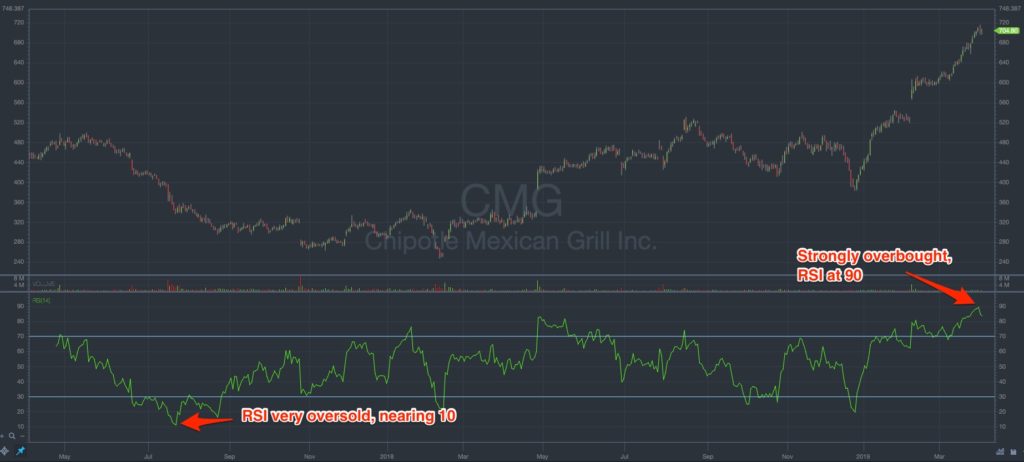Some traders struggle with day trading for a variety of reasons, but position trading can be SO boring … Enter swing trading.
It all boils down to how much free time you have in the markets and your level of experience. How can you find stocks to trade? That’s THE universal trading question. And ultimately, it depends on what you’re looking for in a trade.
So, day traders might look for low-priced stocks with big price fluctuations. Buy-and-hold investors might watch for stocks with the potential for long-term growth.
But what about a trading style that’s somewhere in the middle … like swing trading? With its moderate time frame and focus on trends, swing trading requires different techniques for whittling down your watchlist than other types of trading.
Read on to learn all about swing trading: what it is, its benefits, and how to find stocks when you’re exploring this trading style.
Table of Contents
What Is Swing Trading?
Before we go any further, let’s start with the basics: What is swing trading?
Swing trading can be a happy medium between day trading and position trading. It’s a specific trading method where you hold the stocks for a short yet unspecified amount of time. So you might hold a position overnight or even as long as a few months.
It’s less about the time period and more about trying to milk a trend. A swing trader’s goal is to hold the stock long enough to try to profit from price swings. And that’s, incidentally, where this trading style gets its name.
Like anything else, though, swing trading is only effective if you’re able to identify the right stocks. That’s why using a stock screener, like StocksToTrade, to find new opportunities is so important.
Capital Requirements
Don’t worry about not having enough capital to try swing trading — there are no minimum capital requirements to get started.
But, in order to avoid having to meet capital requirements, be careful and avoid meeting the requirements to become a day trader. Day traders are anyone who makes at least four trades in a five-day period that are opened and closed on the same day.
Once you become a day trader, you’re required to keep at least $25,000 in your trading account at all times.
Why Swing Trade?
Why try your hand at swing trading instead of another style of trading? Well, there are plenty of reasons to consider giving swing trading a try.
First, swing trading is a great way for beginners to get their feet wet in the market. Day trading is a very fast-paced environment and can be very overwhelming for new traders. Swing trading can be slower and give you more time to consider your next move.
Even if you’re not a beginner, swing trading offers great profit potential for more advanced traders.
Ultimately, swing trading is a nice balance between day trading and long-term investing while still offering plenty of profit potential.
That’s not to say swing trading isn’t risky — any type of trading is. But, for those who put the time into learning how to do it, swing trading can be a rewarding strategy.
Swing Trading vs. Day Trading
Swing trading has some similarities to day trading, but one notable difference might be the timeline. Swing trading is generally short term, but it doesn’t adhere to a specific timeline. Day trading, on the other hand, does.
A day trade is defined as a trade where you both enter and exit your position within the same trading day. That means you buy after the market opens and sell before it closes. The trade may last a few seconds or several hours — but it won’t be more than a day.
That’s not the only difference, though. Day traders and swing traders approach trends differently.
With day trading, a long-term trend doesn’t matter as much as short-term fluctuations. A day trade catalyst might be a juicy piece of news pertaining to the stock or the sector.
With swing trading, traders take a slightly longer view of the trend in play. They’re more interested in the company’s fundamentals as well as the strength and potential duration of a trend when researching a stock.
Let’s say a day trader and a swing trader are both looking for stocks within a hot sector…
A day trader might enter a trade based on a news release about a specific company, aim for profits, and exit the trade the same day.
A swing trader, on the other hand, might look for stocks based on news with greater and longer-term effects on the sector. But that news might not necessarily cause huge movements within a single day.
Example of a Swing Trade

© 2019 Shutterstock
Everything’s easier with an example. So let’s take a look at what a swing trade could look like in the real world.
Let’s say Company XYZ’s stock recently fell due to a negative news catalyst. But, recently, the stock has seen growing momentum and volume.
On top of this, Company XYZ is planning to release its quarterly earnings report in two weeks, and analysts expect the company to beat earnings expectations.
In anticipation of this positive news catalyst, you decide to buy a lot of shares in Company XYZ in order to ride the upward price swing. Then, after the earnings report is released and the company’s price peaks, you sell your shares for a profit.
This, of course, is a very basic example, but you get the picture. Essentially, swing trading is about riding relatively short-term price swings to try to make a profit.
Advantages of Swing Trading
Is swing trading right for you? Consider some of the perks that come with this style of trading…
A slower pace than day trading. The supersonic speeds of day trading aren’t for all traders. Swing trading can move a bit slower — just enough that new traders can get involved without feeling overwhelmed.
That’s not to say swing trading is totally free and easy. You still need to stay on top of your trades, ready to respond to stock price movements. But the pace can be less hectic than day trading.
The opportunity to create strong trading plans. With swing trading, you have a little more time to devote to research and plotting out a strong trading plan. It can be a great way for new traders to establish good habits.
Swing trading requires that you set deliberate entry and exit points and that you carefully monitor the stock’s performance. You want to make sure a stock performs according to your original thesis that got you into the trade.
It’s a fairly low-maintenance approach, but it’s not so relaxed that you’ll lose interest or get lazy about monitoring stocks, which can sometimes happen with longer holds.
Risks of Swing Trading
Those advantages might sound great, but like everything else, swing trading also has its risks.
Risk management is one of the most important aspects of trading, so be sure to keep these cons in mind when you’re putting together your trading strategy.
Nothing is guaranteed. Swing trading is all about trying to identify significant price swings. While there are a number of indicators and stock screeners like StocksToTrade that can help you identify these opportunities, nothing is ever guaranteed. That’s just the nature of market speculation.
The timing can be difficult. Swing trading might not be as hectic as day trading, but it still requires nearly constant monitoring and decision-making. If you’re trying to swing trade alongside a full-time job, you might find it difficult to keep up.
Pattern-day-trading rules. Swing trading generally takes place over the course of a few days or weeks, but it’s not uncommon for swing traders to make the occasional day trade. Watch out, though, as doing this four times in five days will make you a pattern day trader. That means you’ll have to maintain a $25,000 minimum balance.
Ultimately, swing trading carries many of the same risks as any other type of trading. No matter what you do, you’ll always be subject to certain risks, like volatility and volume.
The most important thing you can do is manage your risk and stick to your trading plan. Make sure to check out StocksToTrade Pro to learn how you can put together your own rock-solid trading strategy!
Swing Trading Strategies
Curious about some of the specific strategies and tools swing traders might use? Here’s an overview of some common ones:
Using Bollinger Bands®
Bollinger Bands® are a popular technical indicator with swing traders. They’re a duo of lines that represent positive and negative standard deviations from the SMA (that’s the simple moving average) of the stock’s price.
When you look at Bollinger Bands® overlaid on a stock chart, you can begin to see some information about potential trends.
The idea is that if a stock’s trend is strong, its movement will approach the upper band. If it’s weak, or weakening, it may approach the bottom band.
It’s not always an absolute truth, of course, but the bands can offer a suggestion of the trend’s strength.
Watch the RSI
Chipotle Mexican Grill stock shows RSI at extreme levels (source: StocksToTrade)
The RSI (short for relative strength index) is a super popular indicator that can help traders gauge the strength of a trend by measuring its gains and losses to see which way the momentum is swinging.
When you take a quick look at a stock’s performance, it can seem like it’s all over the place. The RSI can help you make sense of gains and losses, measuring them against each other within certain time periods to help you see the dominant movements.
RSI is shown as a number between 0 and 100. Usually, 30 and 70 are the ‘magic’ numbers that traders look to as indications of oversold or overbought conditions. By combining the RSI with Bollinger Bands®, swing traders can gain more confidence about the trend’s direction.
Golden Cross
It might sound like an artifact from “The Da Vinci Code,” but the golden cross is actually a type of candlestick pattern. With the golden cross, a short-term moving average crosses the level of a long-term moving average.
The long-term indicator is the slow, plodding movement — but the short-term movement can be seen as a sign of bullish movement in the near future, especially when paired with unusually high volume.
Support and Resistance Strategies
As a swing trader, working with support and resistance levels can help you refine your entry and exit points.
The breakout strategy, for example, is where traders try to take a position in a stock before it breaks resistance levels. The big hope is that it will explode, and traders want to ride the momentum.
In pursuing this strategy, a trader must set a sound entry point. The aim is to be ahead of the curve and get a favorable price. So think not just about resistance but also support when timing an entry.
Using support and resistance strategies isn’t just a matter of looking at the chart and saying “yay” or “nay” though. Traders should also use indicators to confirm trends, check out the company’s fundamentals, and follow the news.
Is Swing Trading Profitable?
The big question: is swing trading actually profitable?
Unfortunately, there’s no real answer here. Like pretty much any other type of trading, swing trading can be profitable. That doesn’t mean it will always be profitable.
The truth is that there are a lot of factors outside of your control that can affect the outcome of a trade. You might buy shares of stock with the expectation that it will rise soon, only for the company to face a major scandal days later, causing the stock to plummet.
This shouldn’t discourage you from trying swing trading, though. This is true for any type of trading.
What’s important is that you make the effort to develop a strong trading strategy. Following your strategy, using a stock screener, and knowing when to cut your losses are keys to mitigating your risk.
The good news is that you don’t have to learn how to do this on your own. With StocksToTrade Pro, you’ll learn how to develop your own strategy and trade like a pro under the guidance of Tim Bohen — StocksToTrade’s lead trainer.
Best Indicators for Swing Trading
Indicators are crucial for successful trading. They help you find the stocks that are worth trading and can tell you when to buy and sell them.
Let’s take a look at a few of the best indicators you should use for swing trading.
Relative Strength Index
The relative strength index (RSI) is a great indicator that can tell you when you should enter the market.
The RSI can tell you when the market is being overbought or oversold, or if it’s flat or range-bound. It also analyzes past performance and volatility to determine whether or not a stock’s price is secure.
This indicator is mainly useful for finding divergences (reversals in trends) and identifying the conditions that lead to the market being overbought or oversold.
Moving Averages
Moving averages are helpful for identifying or confirming a trend based on past prices. This indicator is great for swing trading, day trading, and long-term investing.
To calculate the average, you need to add the closing prices for a certain period, then divide this number by the number of days.
To use the indicator, you need to calculate multiple averages and compare them. You can use these averages to spot trends and identify reversals.
Volume
Volume is one of the most basic and most useful indicators you can use for almost any type of trading, including swing trading.
Successful swing trading relies heavily on being able to spot trends and predict price movements. However, trends need to be accompanied by increased volume. More volume means more money behind the stock.
Take Advantage of StocksToTrade Features
There are so many stocks to choose from that traders can become overwhelmed super fast. Decision fatigue is real! And there can be points where, as a trader, you just want to buy something, anything.
Don’t fall into the FOMO trap! A great stock screener can help you streamline your research and assist you in creating a strong watchlist. With StocksToTrade, you’ve got a one-stop-shop screener, with plenty of technical analysis tools, news links, and broker integration. You can even execute trades right from the platform!
Why not let StocksToTrade help you with some of the heavy lifting? That way you can focus on your research and building smart trading plans. Get your 14-day trial for just $7 now.
Conclusion
Like any other type of trading, swing trading tends to suit those who are willing to do thorough research.
Because swing trading involves longer holds than scalping or day trading, it’s key to do your research on the stock and the potential of an uptrend. This includes not just using technical indicators but doing thorough fundamental research as well.
Swing trading might not be as stressful as day trading, but don’t let that be an excuse to be lax in your approach. Take the time to collect data, then use it to craft detailed trading plans.
And remember: Your trading plan is only as valuable as your commitment to stick to it.
What’s your go-to trading style? Tell us what you think of this post — leave a comment!











